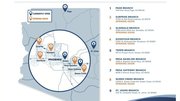Article
Facilitated Rural Branches: An ATM-centric idea rural India can bank on
In rural villages where the nearest ATM might be a 15-minute bus ride away and branch setup is not viable, FRBs can be a cost-effective alternative.

August 28, 2015
by V. Balasubramanian, president of transaction processing and ATM services, Financial Software & Systems
It is estimated that about 40 percent of Indians do not have access to formal financial services. Extending affordable banking and payment solutions to this unbanked population is an avowed goal of the Indian government.
In August, 2014, Indian Prime Minister Narendra Modi launched an ambitious financial inclusion program, Pradhan Mantri Jan Dhan Yojana, or PMJDY. The core objective of the program is to ensure that every citizen has a bank account and a debit card. It has been a huge success, having already covered 99.74 percent of households.
In fact, PMJDY has entered the Guinness Records for opening the highest number of bank accounts in the shortest time anywhere in the world. Within about five months of its launch, the scheme added 10 million new bank accounts. As of July 2015, there were over 17 million new accounts, out of which about 10 million were in rural India.
Where to swipe?
Though this bank account coverage is impressive, only a small portion of account holders are transacting with banks or using debit cards. On average, the activation of card is just 25 to 35 percent at public sector banks and 35 to 40 percent at private sector banks.
Among the key structural bottlenecks that come in the way of transaction and card use is the lack of banking and ATM infrastructure. Most villages do not have ATMs — the nearest ATMs often are located in towns a 10- to 15-minute bus commute away. Of the 200,000-odd ATMs in India today, approximately 25 percent of them are in villages, where a vast majority of the unbanked population lives.
The penetration of bank branches in rural India is low, too. Reserve Bank of India, the nation's central banking institution, continues to push public and private sector banks to open more branches in rural areas. Banks are required by RBI to locate at least one-quarter of new branches opened during a year in unbanked rural centers.
However, everyone knows that rural branches are not viable; we are talking about villages with a population of 2,000 or less. And RBI estimates that there are about 73,000 such villages. The business volume and number of transactions generated in these communities do not justify setting up a full-fledged branch.
Technology-enabled financial inclusion
Banks have tried different branch models in the past, including microbanks. However, many are now convinced that there is a need for a bold re-imagination of rural branches in order to bring banking services to India's 600,000 villages.
Needless to say, technology has to be a core component of the solution. Today the "facilitated branch" is a hot topic of discussion in banking technology. FBs are well-connected, ATM-centric urban branches that, with just one or two staff members, can provide the entire gamut of services to customers.
My thinking is that we need to conceive a facilitated branch model exclusively for rural India. Call it the "Facilitated Rural Branch." This technology-driven model can offer not only banking services to rural customers but also payment solutions to retailers who currently are unable to accept cards for want of connectivity and settlement mechanisms.
FRBs are viable
FRBs can be one-person branches equipped with versatile ATMs and video conferencing facilities designed for India's tier III cities, towns, villages and remote settlements. Compared with a conventional branch, setting up an FBR should cost less — because it can be customized to suit the requirements of a given location.
There is also scope for banks to join hands and set up shared FRBs. This way, customers have the option to transact with the bank of their choice and banks have the benefit of reduced operating costs.
Employment and entrepreneurship
Even a local youth with basic IT and administration skills can be trained and appointed to facilitate basic banking operations. For advanced deposit and loan products, this local facilitator can connect customers with experienced bank staff via video conferencing.
FRBs can create thousands of facilitator jobs in rural areas — good news for banks who find it difficult to convince their staff to work in villages. Customers will feel comfortable dealing with local facilitators because who understand their requirements and speak their language.
We can make FRBs more inclusive by developing them as a rural entrepreneurial venture. In fact, we at FSS are running a pilot project in Madhya Pradesh on maintaining ATM infrastructure based on micro entrepreneurship model.
Each entrepreneur takes on ownership and maintenance of 20 ATMs — making sure that machines are stocked with cash and available for service. For this, entrepreneurs earn 15,000 rupees per month.
In the next phase, we are planning to train these individuals in the repair of ATMs so that they can become more resourceful and earn additional income.
FRBs can handle payment and settlement needs of local retailers. What's more, they can offer a secure environment for people to purchase goods and make payments online.
Thus, FRBs can act as a one-stop financial supermarket for rural India. However, making FRBs a reality requires a multistakeholder partnership involving not just banks but payment solution providers, ATM and banking technology players, telecom networks, and others. Technology and partnerships are the solutions to financial inclusion and making rural economy a digital economy.














